

WWI Heavy Battle Tank Mk.IV 'Male'
Takom 1:35 Scale Kit #2008
WWI Heavy Battle Tank Mk.IV 'Female'
Takom 1:35 Scale Kit #2009
Review by Terry Ashley
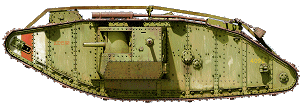
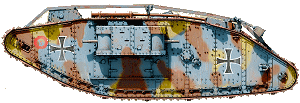
Kit 2008: "Male" consists of:
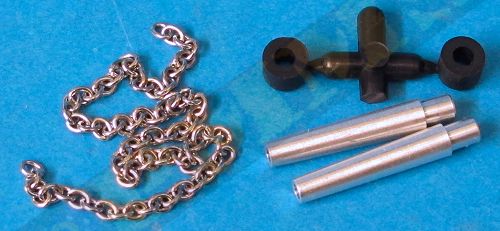
|
Kit 2009 "Female" consists of:
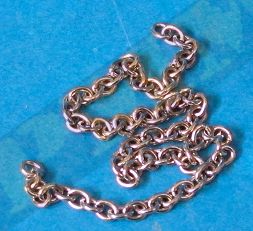 |
Moulding is clean and crisp with virtually no flash or pin marks, each of the 4 main hull sections are in one single large moulding and it also includes the chain drive inside the rear hull (in plastic) although this is hidden after assembly. The only real clean-up needed is the many mould seam lines which on some parts is fairly heavy but easily removed with #11 blade or by sanding.
The detail on large outer hull mouldings is included on both sides without any hint of pin marks with the inner hull in six main sections that also have excellent rivet and panel details with bevelled edges and long tabs for precise location of the parts. All the pistol ports are moulded in the closed position but the front Commander’s/Driver’s visors and hull top lookout hatch are separate parts that can be shown open if you wish. The many hull rivets are quite pronounced as they were on the real thing and perfectly formed to give a good impression from usual viewing distances.
The only interior is the full 6pdr gun and breech and mounting as well as the full Lewis guns although this is basically hidden after assembly apart from what can be seen though the rear sponson door if left open?
The kit has individual link workable track but the assembly required for the track is quite daunting as we will see below and does require considerable assembly.
I don’t have any accurate 1:35 plans for the Mk.IV but available data suggests the kit is accurate in overall dimensions and has all the features of the Mk.IV nicely represented although as we will see some modelling experience will come in handy as assembly requires care to get best result.
The Lewis gun has the full breech and shoulder stock, handgrip and separate ammo magazine and this is fitted into the Skeens ball socket that includes the sighting aperture, but the gun fit into the ball socket is quite loose and you need to glue the gun into place with thicker tube cement and ensure the barrel sits perfectly central in the ball as the glue dries for the best appearance. Once the glue has dried on the gun/ball join this is held in place on the inside of the front plate with a collar to allow for full movement of the gun/ball after assembly.
The front driver’s plate has separate vision flaps but the actual flaps have additional separate smaller vision flaps at the top to allow for forward vision without opening the full flap but this smaller flap is moulded together with the larger piece so can’t be shown open as is often the case.
It is best to fully assemble the Commander’s/Driver’s compartment and fit this to the hull top plate before assembling the remainder of the hull panels as opposed to assembling this while joining the other hull panels as shown in the instructions.
To ensure the correct angles of the panels I temporarily sat the hull panels into the locating channels on the side rhomboid hull sections (using these as a ‘jig’ for better description) while the glue dried on the main hull taking care not to glue to the side hull at this stage.
With the main hull sections assembled the smaller details can now be added with the front towing hook assembly fitting without problems, on the top are separate mounting brackets for the exhaust muffler, these give excellent detail definition with the small gaps between the roof and the brackets, there are also etched securing strips for the exhaust muffler to further enhance the detail. Note the two forward mounting brackets are wider than the third and while clear overhead shots are hard to come by I have seen photos showing the three mounting brackets the same width and with the front two wider as depicted on the kit so both configurations are possible although the three the same width appears to be the more common. Some additional details can be added to the muffler if you wish, there is a weld line running along one side of the muffler and four retaining bolts on the end where the pipe exits the muffler, also the etched strip bolts can be enhanced with possible resin or plastic replacements for better definition.
There are several cross members added to the roof but these are a little chunky in appearance and could be thinner in profile, the separate rear storage box is made up of four sides and six small etched discs for detail with the fit of the box sides being good as is the fit to the hull roof. Note you must fit the long exhaust pipe before fitting the storage box or the exhaust pipe cover (part E19) but this should be quite obvious really.
I don't usually mention something that isn't on the kit (and shouldn't be) but both the Emhar and Tamiya Mk.IV kits have two square access hatches on the rear top hull inside the confines of the storage box but the Takom kits don't have these hatches. Indeed the exhaust pipe is located over the top of the left hatch on both these kits so you aren't going to opening it any way. But to the point, I have not seen these two hatches on any available period image of Mk.IVs (Male or Female) or in any of the books listed below or on any of the preserved museum examples other than the Bovington Tank Museum's example. These hatches were added postwar and should be removed from both the Emhar and Tamiya kits. The Takom kits depicts the rear section correctly without these hatches.
The rear lookout hatch has three angled sides that fit together okay and fitting these to the roof is straightforward with the hatch sitting on top, but there are few detail issues with this hatch. Firstly the hatch (and angled sides/rear section) is too narrow at the rear top edge, it should be 10mm wide in 1:35 scale (give or take a fraction) but the kit hatch is 8.25mm giving it a narrow appearance while the length of the hatch is okay. There should also be a small notch on the top left corner which can easily be added using a drill and #11 blade. There should be four retaining rivets for the hinges at the thicker end (only 2 on the kit hatch) and three bolts and a rivet at the thinner end of the hatch (not on the kit hatch); these hold the inner items in place. The top corners of the hatch should also be rounded and not square as depicted on the kit hatch and lastly the hatch should actually overlap the base side a little. The hatch can be positioned open or closed but as there is no interior closed would be the best option.
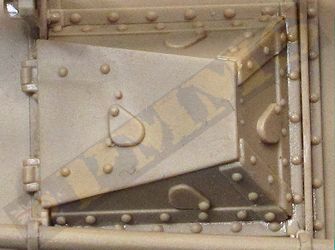
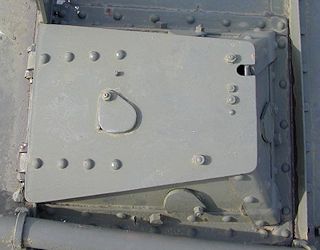
Reference image svsm.org
One item missing is the roof top pistol port that should be located next to the lookout hatch, this is easily added from thin plastic card and a few small rivet heads.
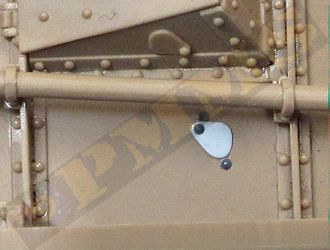
At the rear is the armoured fuel tank made up again of separate panels that fit together without any problems and have excellent surface details included along with two small etched top brackets, note these bracket s sit slightly above the top surface attached only to the raised sections on the side plates. The assembled fuel tank fits precisely to the rear hull that again has nicely done surface details included, the access door is moulded in the closed position but again as there is no interior this shouldn’t be a problem. The separate left side air intake louvers have excellent detail with a separate top cover with the correct contours and this adds to the detail definition on the rear hull plate with there being no fit issues with these parts.
Before tackling the main assemble the small curved backing plates for the idler adjustment mechanism should be fitted (parts C2) as well as the small brackets at the rear (parts E22, E23) which have small etched brackets added, plus the rear mounted towing hooks.
These hooks are positioned on both inboard and outboard sides of the rear hull and the kit has these attached to the final drive bearing covers (parts C7, C8) in both positions. Period photos show the outboard hooks mostly on the final drive covers and the inboard hooks mostly on the drive sprocket bearing covers but there are variations to this as with most things and it’s best to check the position if modelling a particular tank if photos exist? The position of the hooks based on period photos is the same for both Male and Female tanks.
Also included is an accurate representation of the final drive chains and drive sprockets (in plastic) fitted inside the rear hull sections as well as the inner bulkheads but unfortunately none of this detail can be seen after assembly so you may wish to leave this out and save a little on assembly. If you do include the chain drive (because you know it’s there) then make sure the small rear chain drive sprockets (parts C13, C14) are not glued to the chain drive but left free to rotate as these do intermesh with the main drive sprockets as they do on the real tank and will prevent the drive sprockets from rotating if glued in position.
The two large hull sections are joined by a series of inner panels with those at the rear having additional detail such as the mud channels and inner sprocket covers as well as the top mounted road wheel rollers for guiding the track over the hull to the top channels. There are two types of road wheel rollers used on the Mk.IV (more on this with the road wheel section below) but the kit gives you the incorrect type for the hull top position as it should be the wheels with the inner flanges but as these can’t be seen after fitting the tracks it’s not really an issue unless modelling the tank without the tracks fitted for whatever reason.
When fitting the inner panels it is important to firmly press these into their respective locating recesses as the glue dries to ensure the best fit as there is scope for these not to be seated properly if just sat in place, with the lower front panels you should fit parts (C27) first and then parts C31 to ensure they sit at right angles. There were no other fit problems ensuring you note the part numbers and orientation of the inner plates (E8, E9, E10, E11) to fit these in the correct position and as mentioned firmly press into place as you go.
The instructions would have you attach one of the drive sprocket and idler discs to one side of the hull and then fit the other sprocket/disc in place but it is better to assemble the drive sprockets and idlers before attaching to the hull and also ensuring the sprocket teeth align correctly. The rear drive sprockets are easy to fit in place after the inner hull drive detail has been fitted if you intend to use these parts. Both the sprockets and idlers are meant not to be glued if you want these to rotate and also there is three alternate positions for the front idler to get the best track tension but as you don’t know what this position is till after you have assembled the hull and track later it’s a bit of a guess to the position of the idler at this point. Before fitting the other hull section you must assemble the road wheel rollers and fit these to the hull so we’ll come back to the final hull assembly after dealing with the road wheels.
These road wheel types are mixed when fitted onto the lower hull and the instructions have a plan side view drawing that clearly shows to location of the types so follow this as you fit the road wheels. Also the instructions indicate to not glue the road wheels in place but leaving then free to rotate but when fitting the two hull sections together you have to work from one end to align the panels and wheels and those further along just kept popping out of their locating holes and it will save you a lot of hassles to glue the road wheels to one hull side (the same one you have glued the inner joining panels too earlier) before fitting the other hull side. There is no need for the road wheels to rotate after assembly in any case so this shouldn’t cause any problems later.
There was an issue when fitting the first and last road wheel groups as these are alternate flat and flanged wheels and there were minor problems getting these together with the axles at 90 degrees and I have to trim a little off the smaller flat road wheels to allow a proper fit but test fitting will determine if this is a problem with you suspension?
With the rear section glued you can then glue the middle section again keeping them firmly pressed together for best fit and finally the forward section is glued in the same manner. This assembly is then repeated on the other rhomboid hull assembly and these are left for the glue to dry completely before fitting the main hull assembly. I have used Tamiya Extra Fine Cement as this ‘goes off’ and ‘grips’ quite quickly but any good quality liquid cement should do the job, but if using cement that takes longer to grip you will need to keep the hull assemble clamped together for longer to get the best fit.
Fitting the two rhomboid hull sections to the main hull is fairly straightforward as the fit is good overall but you will again need to keep the assemblies firmly pressed or clamped together until the glue dries to ensure the best fit as there is scope for these to slightly move and leave small gaps if not careful. Note the fit here is helped by using the locating channels on the inside of the rhomboid hull sections as a jig when gluing the main hull panels together as mentioned about because if there is any miss-alignment of the main hull panels this will make the final assembly more complex.
Each link is assembled by gluing the four brackets noting the correct position of each individually numbered bracket. With the first link assembled you then assemble the next in the same manner with the instructions saying to allow the glue to dry completely before fitting each assembled link together. The links are designed to clip together with the pins on one clipping into the corresponding holes on the next link bracket, but I found it better to fit each link together while the glue was still pliable to allow enough movement to fit the brackets over the pins and then squeezing the brackets together over the pins using pointed tweezers to secure the join.
There were a couple of issues during assembly, you need to be very careful to glue each of the four brackets perfectly aligned or you can easily end up with links not parallel in the final track run (see image) and also one bracket (part B2) wanted to creep forward in the shoe locating flanges and to correct this I actually cut one of the brackets B2 in half to get the pin alignment back on track but the creep continued and needs care to prevent this as the flange locating recesses seem to encourage this ‘bracket creep’.
After assembling about 20 links I attempted to test fit these to the kit sprockets only to find they didn’t fit without thinning the sprocket teeth to about half their thickness. The other issue is the joins with the small pins are very weak and kept coming apart with only moderate handling so I would say it would be best to dispense with the workable bit and just glue the links with brackets together around the hull and sprockets. The instructions mention that you can just glue the track links around the hull without the inner brackets but this is not practical as the track on the real vehicle does not hug the hull all the way around with the inside brackets visible in quite a few areas.
There is also another small issue regarding the drive sprockets themselves.
The width of the two sprocket discs at their centre line of each sprocket is 9 inches or 6.53mm in 1:35 scale.
Unfortunately the sprockets discs in the kit has a width of 5.75mm which at 0.78mm difference may not seem a lot and if used with the kit track should not be a problem. But if modellers wish to use the metal Friulmodel tracks or others that are designed for the correct 6.53mm width they unfortunately don’t fit the kit sprockets without widening the spacing between the sprocket discs or using the metal sprockets provided with the Friulmodel track in that case.
Also included are the grouser spuds sometimes used with the track for additional traction with 30 spuds included in the kit, 15 per side and these are usually fitted on every 6th track link although as with any rule there are variations as seen in some photos. Fitting the spuds is easy, you simply glue them to the intended track link as required, note the instructions don’t say these spuds are an option but to fit them as a matter of course but they weren’t fitted as standard, only when required and when not in use were stowed in the large storage box on the top rear hull.
if you wish to use aftermarket tracks such as those from Friulmodel, a quick guide to fitting these to the kit is here.
The sponsons are made up of separate panels with a combination of bevelled edges and recesses for fitting the panels together and you must ensure perfect alignment of the panels as you go because a small miss-alignment of one will affect the next and so forth. The panel joins are good overall and in some ways too good as the joins between the panels on the actual tanks are quite noticeable with square edges at the join while the kit panels with the bevelled edges form a smooth join.
Note the part numbers here refer to the left sponson; check the instructions for the corresponding right sponson numbers. I first assembled the gun mount (parts G16, G17) onto the lower plate (G14) as this gave the correct angle for the lower plate (G1) and then the small side plates (G27, G32). The gun shield flanges (G8, G3) were glued to the inside of the outer plate (G4) and allowed to dry ensuring they set at perfect right angles to the outer plate. Next the front plate (G10) is attached again taking care to align this perfectly with the assembled lower section and the outer plate with flanges can then be fitted ensuring the joins are aligned perfectly as you go. The two small inside plates (G26, G51) are also fitted into place and there were no fit issues here providing you ensure everything is aligned perfectly before gluing as these is scope for gaps if not careful. The rear plate (G13) has the entry door (G7) separate and there were no problems fitting this perfectly along the bottom edge and front join to complete the main sponson assembly.
The final part fitted is the roof panel and this did not fit perfectly level with a small gap towards the rear edge and after checking the fit it was appears the height of the rear plate (G13) was slightly too high meaning the roof wouldn’t fit precisely. This was only a very small amount (0.5mm) and to get a perfect fit I reduced the height of the inside locating recess on the rear plate by 0.5mm and also reduced the height of the actual rear plate by the same amount. After this minor adjustment the roof fitted perfectly level and this adjustment was required on both sponson rear plate/roof joins which shows it wasn’t a miss-alignment of parts on the initial assembly. That was the only panel fit issue with the sponsons (or hull). Another way of tackling this would be to fit the end panel slightly lower so the top edge is level with the front sponson plate and then trim the lower edges flush with the surrounding panels although I have not done it this way as I didn’t discover the issue until after gluing the rear plate into position.
See Image:
The rear doors can be positioned open or closed as you wish with nice interior detail included on the door as well as the lower shell ejection opening, there are a couple of shallow pin marks inside the ejection recess but these are easy to remove if you are showing the door open?
There is another adjustment required before fitting the sponsons to the hull sides.
As mentioned the guns are held in place in the base by way of poly caps but there is nothing to keep the guns perfectly upright meaning there can be uneven gaps between the curved gun shields and the sponsons sides once fitted, also when rotating the guns a few times these tended to “walk” up in the poly caps mount increasing the gap at the base of the shields and once fitted to the hull there is no way of pressing the guns back into the base poly cap. To fix this you need to add a spacer made of 1mm plastic card under the roof above the gun shields to firmly hold the gun shields in place and preventing gaps appearing at the sides.
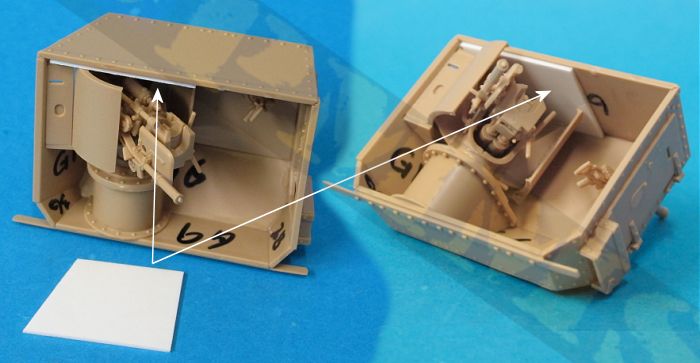
With the sponsons assembled they can now be fitted to the hull sides and apart from ensuring the mating surfaces are smooth there was no other trimming needed for a good fit.
Firstly the mountings are added to the Lewis guns, the two collars (parts H21, H27) must be set at right angles to the gun as there is no actual locating pin to ensure the correct alignment, the small curved front shield (H2) and side brackets (H1) are then attached and the assemblies left to dry before fitting inside the shields.
The two side shield sections have L braces added and these must be set perfectly level with the shield sides, also note the different part numbers for the L brackets so you get these in the correct position. The instructions show not to glue the small gun mounting collar (parts H22) to the shield mounting but it’s better to actually glue this to the shields to save a bit of hassle during final assembly.
I also found it easier to fit the front shield section (H10) over the Lewis barrel and glue to one of the side shield parts, note don’t glue the pin on the Lewis bracket (H1) to the mounting collar (H22) if you want the guns to elevate. With the shield partially assembled in this way it is far easier to then fit the other shield section over the gun pin and glue in place to the front shield without trying to juggle the complete assembly at once. Note the shield joins must be completely eliminated after gluing and the top and bottom edges sanded even before fitting the sponson base.
The turret mounting plate (H15) is then attached to the undersides of the shield L brackets by way of small locating pins on the brackets but these simply did not align with the holes in the mounting plates and it was easier to cut off the small bracket pins and glue the plates directly to the underside of the brackets ensuring they are located perfectly centrally and square with the turret assembly.
The assembled turrets are attached to the sponson base panel (H18, H20) by way of a small pin (H34) which is glued into the locating hole on the sponson plate but you need to be very sparing and careful with the glue if you want the guns to move after fitting as it’s very easy to get glue where it shouldn’t go. The fit of the turret to the floor wasn’t that snug leaving some lateral movement of the turret which caused some minor alignment issues when the sponsons were assembled as we will look at below.
The sponsons are made up of separate panels with nice rivet and panel surface details with a combination of bevelled edges and recesses for fitting the panels together and you must ensure perfect alignment of the panels as you go because a small miss-alignment of one will affect the next and so forth. The panel joins are good overall and in some ways too good as the joins between the panels on the actual tanks are quite noticeable with square edges at the join while the kit panels with the bevelled edges form a smooth join.
Note the part numbers here refer to the left sponson; check the instructions for the corresponding right sponson numbers. The lower panel (H31) and lower lip (H33) are attached to the sponson floor ensuring they are set at perfect right angles to each other with the separate lower doors able to be fitted in the open or closed position. There was a slight fit issue with the lower doors as the top edge needed to be trimmed slightly for a good fit as well as the mould seams removed from the door edges to again aid in a better fit.
The upper front plate has nice surface details including the firing ports and vision slits in the closed position and nice rivet detail, this fits neatly to the sponson floor and the angled end sections also fit precisely into place, you will need to hold the joins on the front and end plates firmly together as the glue dries for the best fit. Before fitting the roof section you need to fix the turret movement issue as mentioned above for the gun shields to sit snug against the outer panels otherwise some gaps will result. This is quite straightforward by fitting a bracket made from plastic card strip over the top of the inside shield to hold this in place against the sponson side panels, just ensure you don’t glue the shields while fitting the brackets, see images.
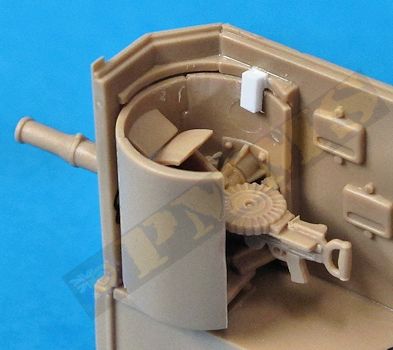
Finally the roof panel is fitted without any problems and the assembled sponson can be fitted to the hull sides, this entails trimming off six hull bolts as shown in the instructions to allow the bottom sponson panel to fit over the hull. I had to also trim the top and bottom of the sponson a little to fit into the hull opening and there is angled raised strips on the inside of the lower sponsons panels designed to sit inside the inner hull opening but these seemed to hinder the fit so I simply cut away these inside raised strips and the sponson then fitted easier into position.
Fitting is easy as each end of the rail attaches to the respective idler and drive sprocket bearing cover and to the top attachment points as mentioned above. Sometimes there is also a small attachment bar going from the etched brackets (TP2, TP3) to the rails but this isn’t always fitted with numerous period photos without this bracket as depicted in the kit but if you wish to include this additional support it can be made from thin plastic strip.
The two part un-ditching beam is included with etched brackets and attachment chain provided and the instructions show this can be fitted in the stowed position on the upper rails with small etched brackets and the chain used to attach to the rail. The additional chain is also stowed in the hull top storage box. The second option provided is for sitting the beams to the track links when in use with the chain cut into small lengths as indicated in the instructions.
The figure is broken down in the conventional manner and assembly is quick and easy without any gaps to deal with. The uniform details are fairly basic and not that well defined as well as the figure being rather chunky for 1:35 scale but if not used with other figures this should be ok. The camera is in two parts with etched brackets for the accordion section for a nice appearance.
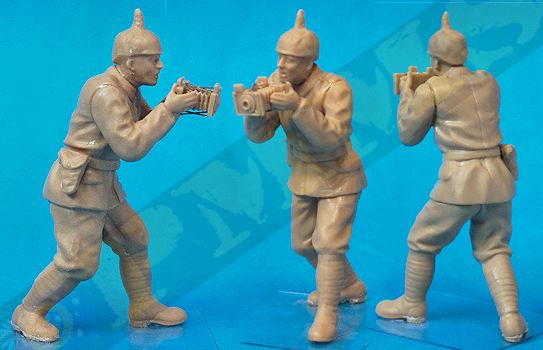
The instructions are in the form of the usual numbered parts in exploded view drawings which are clearly laid out and easy to follow and for a refreshing change there were no miss-numbered parts in any of the sequences after updating those from the correction sheet.
As with any instructions you should carefully study the sequences before any cutting or gluing to avoid any problems but the clear steps aided in making assembly quite straightforward overall.
| Kit 2008 "Male" Option A: "Heinz", Panzer 207, Abteilung 14, Near Fort de la Pompelle, 1918. 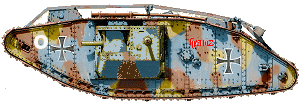 This captured Mk.IV is shown on page 135 of the Tankograd Publishing #1004 Beute-Tanks British Tanks in German Service Vol. 2 , these photos are after the tank has been disabled and abandoned so some of the fittings are missing. The instructions indicate the camouflage colours as Red Brown, German Grey and Dark Yellow yet the colours mentioned in the Tankograd Publishing #1003 Beute-Tanks British Tanks in German Service Vol.1 include Railcar Green, Railcar Red Brown, Clay Yellow and Ivory (interior) used in different camouflage schemes so it’s hard to say what the actual colours used on “Heinz” would be without further references being available. The photos also show the tank has been modified by the Germans and is fitted with the 5.7cm Maxim-Nordenfeld cannon. This requires modifications to the gun shields and additional armour spacer panels around the shields as these were smaller than the British 6pdr shields. The gun mantlet and barrel are also different from the British counterparts and some work will be needed to correctly depict this particular tank in German service. The gun and shields are shown in detail on page 62 of the Tankograd Publishing #1003 Beute-Tanks British Tanks in German Service Vol.1 for those wishing to make the appropriate modifications. Option B: "Lodestar", 12th Battalion, France 1918. The first thing to note here is the colour depictions of the tank on the kit box show a greenish finish but the majority of MK.IVs were painted “neutral brown” in colour with references indicating some may have camouflage patterns with more than one shade, but you are safest to use the overall brown unless specific photos exist showing otherwise. The kit gives the name “Lodestar” and serial No.4098 but according to the Tank Museum “Great War Tank Mark IV” book the original “Lodestar” was serial No. 8081, the serial for “Lodestar II” is not given while “Lodestar III” which survives in original colours at the Musée Royale de l’Armee museum in Brussels and is numbered 4093. The Osprey New Vanguard 133 book “British Mark IV Tank” has a colour illustration of “Lodestar” on page 30 with serial No.4098 which may have led to some confusion over the serial number for “Lodestar” included on the decal sheet? You should also note the White/Red/White strip colours on the front horns are only painted onto the hull and the track tensioner remains the brown hull colour. The box top colour illustration correctly shows this but the B&W instruction illustration is incorrect as it shows the track tensioner as also coloured. 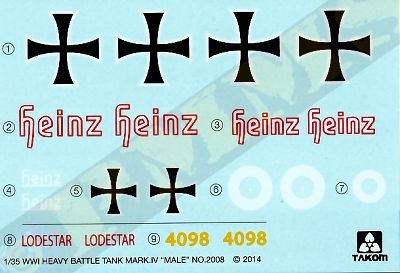 |
Kit 2009 "Female" Option A: "Annchen", Panzer 107, Abteilung 12, Near Fort de la Pompelle, 1918.  This represents a captured Mk.IV Female and has been repainted in a three colour camouflage and named “Annchen” painted on bow and tail with two large Iron Crosses on each hull side with a red circle with the number 5 on the front horns and front of Driver’s compartment to represent Abt.12. Of interest is the photos of “Annchen” in Tankograd Publishing #1004 Beute-Tanks British Tanks in German Service Vol.2 show a single grouser spud fitted to the right track only after the tank was abandoned in 1918. The instructions indicate the colours as Red Brown, German Grey and Dark Yellow yet the colours mentioned in the Tankograd Publishing #1003 Beute-Tanks British Tanks in German Service Vol.1 include Railcar Green, Railcar Red Brown, Ivory and Clay Yellow used in different camouflage schemes so it’s hard to say what the actual colours used on “Annchen” would be without further references being available. Option B: "Flirt II", 16th Company, F (6th) Battalion, Cambrai November 1917. 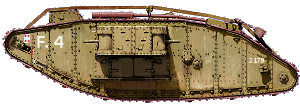 The first thing to note here is the colour depictions of the tank on the kit box show a greenish finish but the majority of MK.IVs were painted “neutral brown” in colour with references indicating some may have camouflage patterns with more than one shade, but your are safest to use the overall brown unless specific photos exist showing otherwise. The decal serial number 2179 is the number given to the Tank Museum Mk.IV Female “Flirt II” and is purely fictional, with Female tanks having serial numbers in the 2500-2799 range, the actual serial for “Flirt II” is unknown as available photos from 1917 do not show the serial number. But the F. 4 on the front horns is correct as is the playing card with 4 hearts so to depict “Flirt II” from the Cambrai action it’s best to use the F. 4 and card but leave the serial number off as seen in the period photos of “flirt II” in the Tank Museum book “Great War Tank Mark IV”. 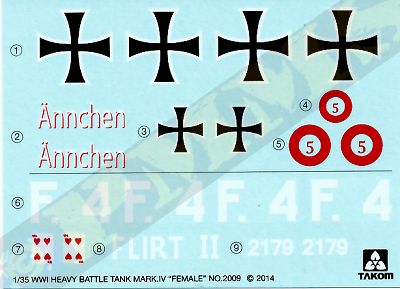 |
The fit of parts is also good but care is needed with the major hull parts to ensure the best fit, although there was one minor fit issue with the Male sponsons as above. There are also some excellent detailed sub-sections such as the hull top exhaust muffler and mountings and rear hull plate detail while others could use a little enhancement such as the hull top observation hatch and the front vision flaps. The metal 6pdr barrel tube with the Male and the full Lewis guns with correct aperture in the ball mountings plus the etched parts add to the definition.
The biggest let down or issue with the kit is the engineering of the tracks with excessive clean-up and parts assembly required with the resulting clip together links being quite weak and tend to come apart with ease. Takom have announced a simply clip together set of Mk.IV tracks to be included with their forthcoming Mk.IV Tadpole kit and these would make things a lot easier than those included with this kit.
Overall these are very good kits of the British Mk.IV Male or Female with pros outweighing the cons tracks not withstanding and will build into impressive models with due care and some basic modelling skills.
Rating 8/10
Click on thumbnails for larger view







Click on thumbnails for larger view
Common Sprues






2008 "Male" Sprue

2009 "Female" Sprues


Common Sprue Detail Images





















"Male" Sprue
Detail Images






"Female" Sprue
Detail Images






2008 "Male" Instructions


























2009 "Female" Instructions
























Close new window to return to page
| Great War Tank Manual David Fletcher. ISBN: 9780857332424 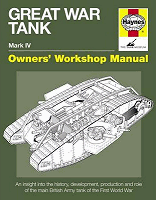 |
British Mark IV Tank Osprey New Vanguard #133 ISBN 978-1-84603-082-6 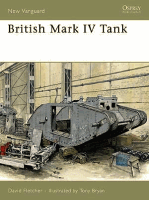 |
Beute-Tanks British Tanks in German Service Vol. 1 Tankograd Publishing #1003 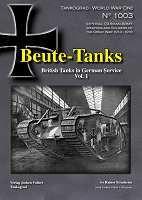 |
Beute-Tanks British Tanks in German Service Vol. 2 Tankograd Publishing #1004 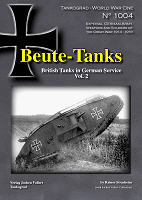 |
Thanks to
 for
the review Kits.
for
the review Kits.Please to help the reviews to continue, thank you

